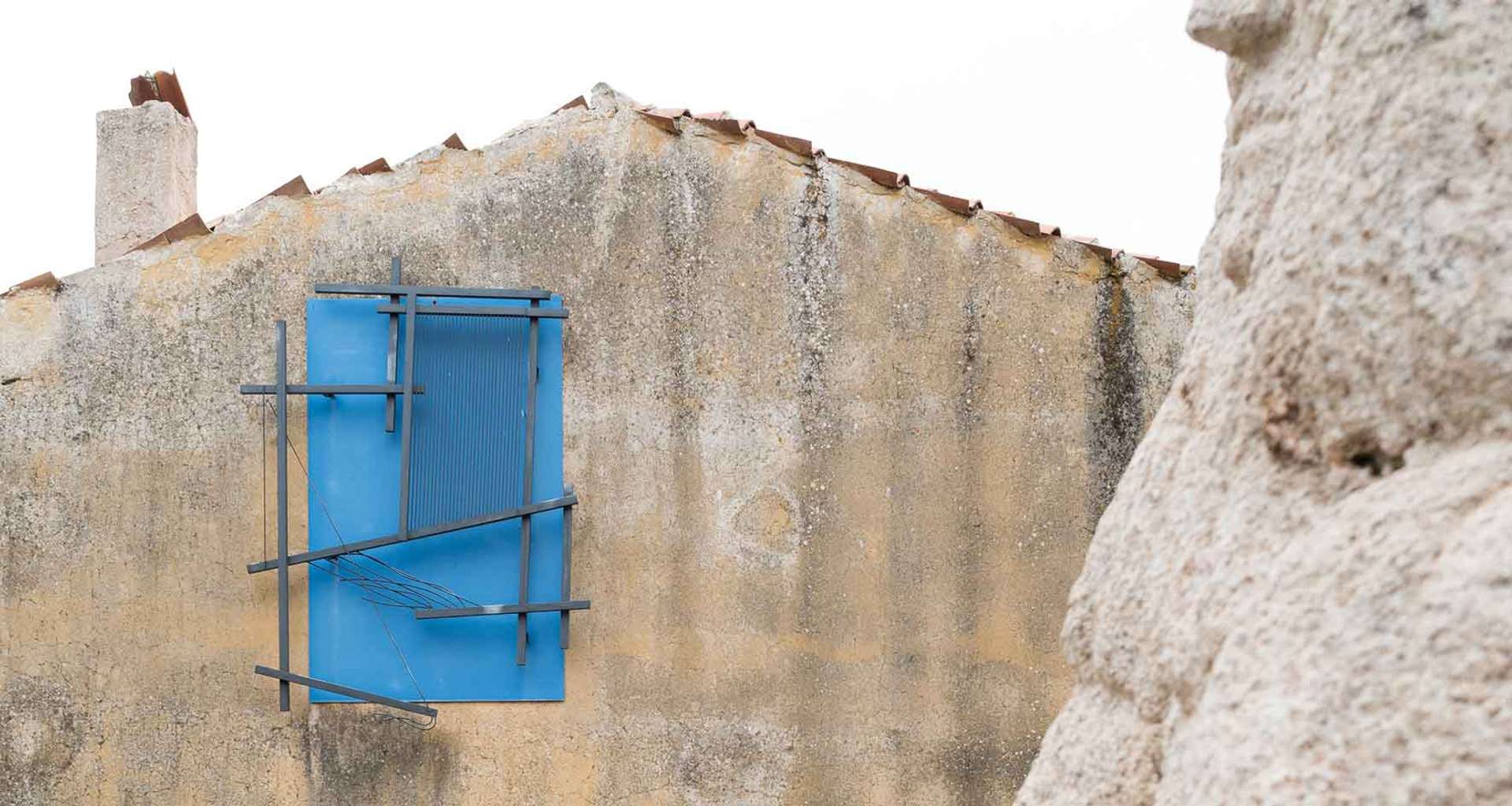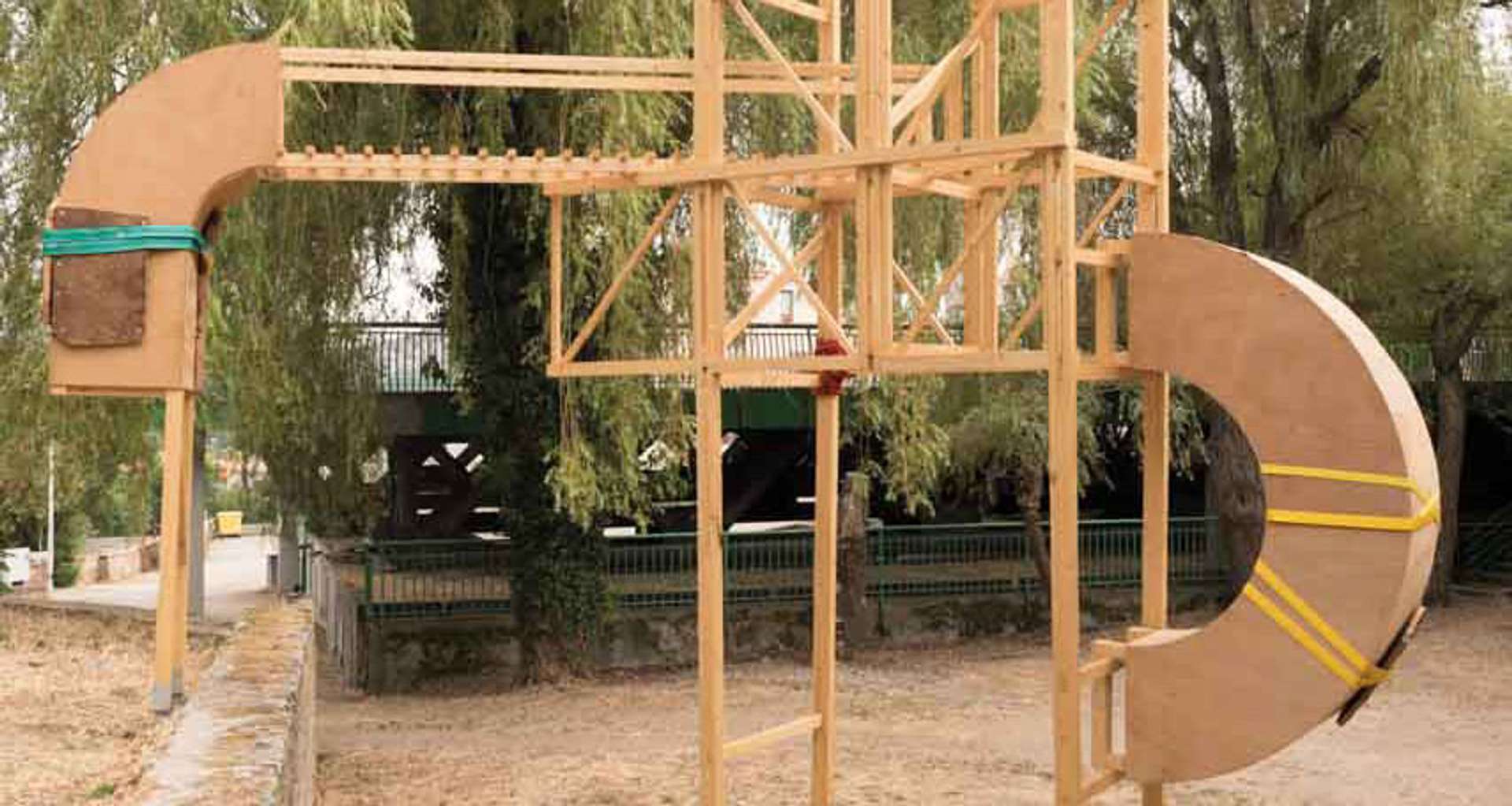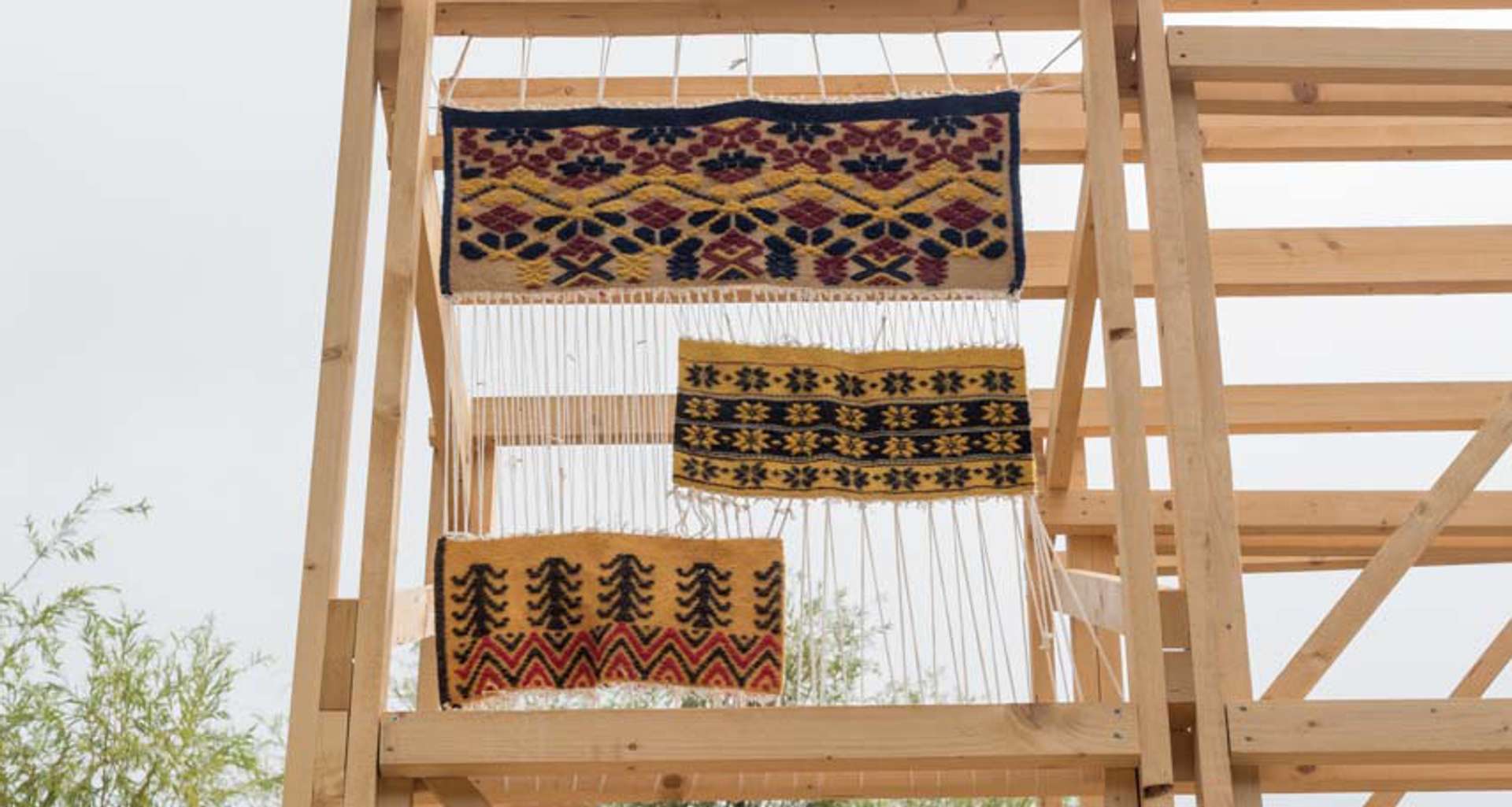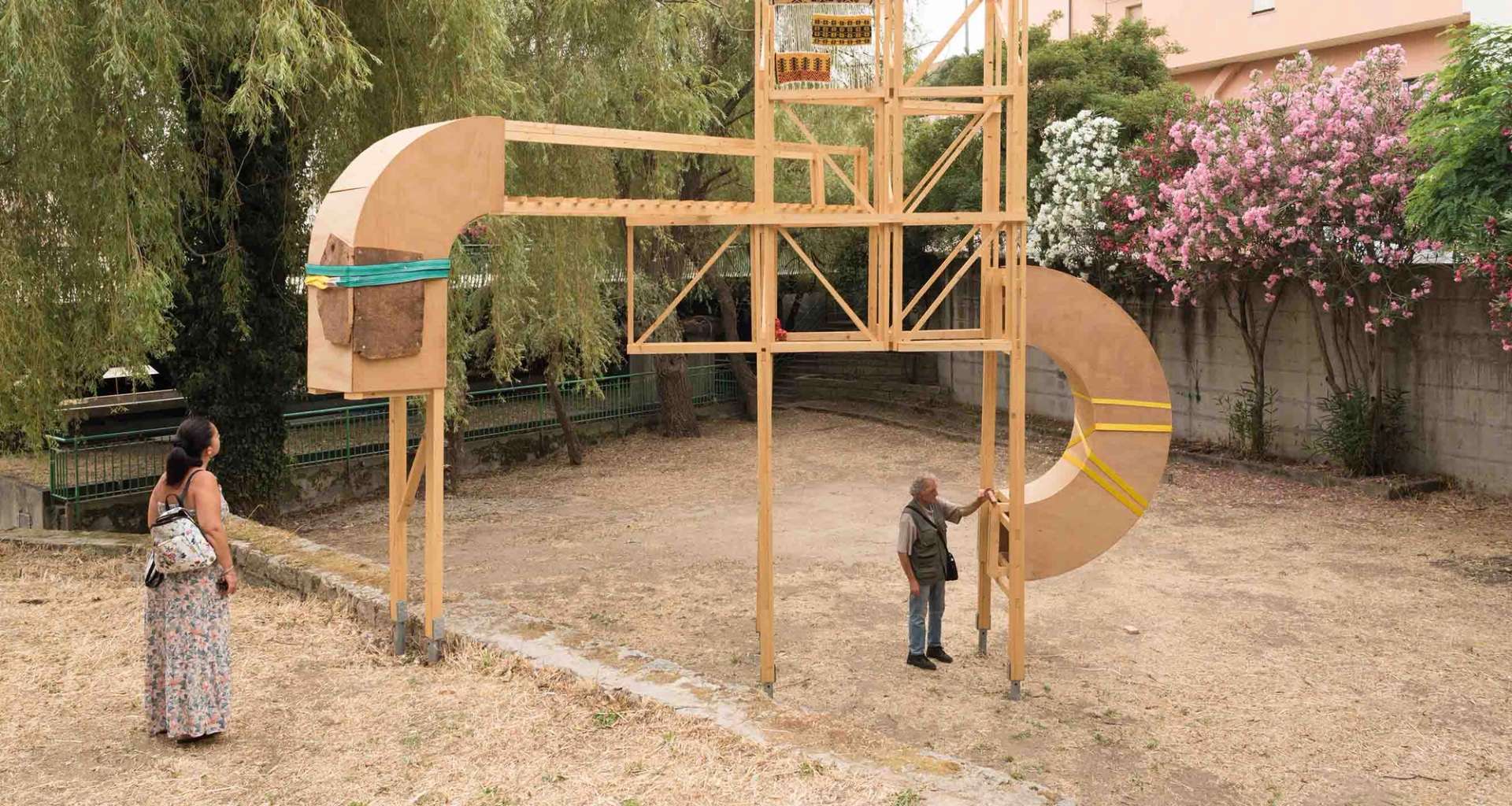Ludovica Carbotta’s intervention in Aggius, a granite village located at the foot of the Limbara massif, is in line with the research started in 2020 and, on the occasion of the third edition of Una Boccata d’Arte, is presented under a new and unprecedented form, a practicable sculpture in relation to the environment and people. Paphos is an architectural installation composed of both natural and artificial elements that, starting from the design and construction of a basic wooden structure, grows in an autonomous, constant and variable way, thanks to the work of the artist and the contribution of individuals, the inhabitants and the visitors, through the insertion of simple materials recovered in some local artisan workshops, such as cork and wool, or recovered and assembled on site.
The production is part of collaborative processes and offers a way to document, tell and reflect on the specific time of the place.
The wooden skeleton of the sculpture was created in collaboration with the architect Giuseppe Grant, part of the collective Orizzontale.
Over time, Paphos will progress in growth thanks to the addition of further interventions. Previous experiences of this research have been exhibited at Bombon Projects in Barcelona (June 2021) and at Sala Veronicas Museum in Murcia (January 2022).
ㅤ
Permanent works:
Ludovica Carbotta, Paphos, 2022, installation, sculpture in evolution, present dimensions 700 x 500 cm.
Aggius (SS), Sardegna
FOR THE VILLAGE OF AGGIUS, THE IDEA IS TO SUBMIT A RISING STEADILY ENTITY: PAPHOS. THE PROJECT I HAVE BEEN WORKING ON SINCE 2020 COMPARES THE NOTION OF GROWTH WITH THAT OF A SCULPTURAL PROCESS. IN THIS CASE, PAPHOS BECOMES A PRACTICABLE SCULPTURE THAT APPEARS TO HAVE ADAPTED AND RECEIVED ITS FORMS FROM ITS OWN GEOGRAPHICAL ENVIRONMENT. PLACED IN PUBLIC SPACE, IT GROWS PROGRESSIVELY, DISPROPORTIONATELY AND IS DRESSED IN ELEMENTS THAT DISTINGUISH THE LOCAL CULTURE, VALUES AND ENVIRONMENT
After graduating in Painting at the Albertina Academy of Fine Arts in Turin, Ludovica Carbotta (Turin, 1982) continued her education by graduating in Fine Art at Central Saint Martins in London. Still in the same city, she obtained a Masters in Fine Arts at Goldsmiths University. Her artistic practice focuses on the physical exploration of urban space and how individuals make connections with the environment they inhabit. Poised on the boundaries between reality and fiction, recent works combine installations, texts and performances that take the form of medium-scale environments. Through them, Carbotta reflects on the notion of site, identity and participation. Specifically, in this phase of her research, she is exploring what the artist herself defines “specificity of the fictional site”, that is, a form of site-oriented artistic practice that takes into consideration both imaginary places and real places that take shape starting from fictitious contexts, recovering the role of imagination as valuable for building our knowledge. According to Carbotta, with the imagination it is actually possible to create a place to belong to, but this will inevitably be influenced by the reality of the language that constitutes it as an object.
Her work has been exhibited in solo and group exhibitions in prestigious institutions, in Italy and abroad, such as Fondazione Sandretto Re Rebaudengo (Turin, 2019) and Fondazione SmART (Rome, 2019), The Drawing Center (New York, 2018 and 2019) and Museu do Louvre Pau Brazyl (São Paolo, 2019). Among the awards she has won, we remember the Special Mention at the Premio ITALIA (MAXXI Museum, Rome, 2016) and the New York Prize (ISCP / Columbia University, New York, 2018). Ludovica Carbotta is one of the two Italian artists selected by Ralph Rugoff, curator of the 58th Venice Biennale, for the international exhibition of the Venetian event.
THE PRIMARY INTENT IS TO COLLECTIVELY RECORD THE PASSAGE OF TIME, TRY TO MEASURE IT STARTING FROM KNOWN ELEMENTS SUCH AS THAT OF BASIC ARCHITECTURAL STRUCTURE. AFTER THE FIRST STAYS IN AGGIUS, ONE OF THE HIGHLIGHTS OF THE EXPERIENCE ON SPOT, WHICH THE INTERVENTION IS INSPIRED TO, IS LINKED TO THE RELATIONSHIP OF THE INHABITANTS WITH TIME, ELEMENT THAT CAN BE FOUND BOTH IN THE WOOL WEAVING ACTIVITIES AND IN THE LANDSCAPE CARE. IDEALLY, THIS KIND OF FORMAL GENESIS WILL HAVE, STRICTLY SPEAKING, NEITHER A BEGINNING NOR AN END
Aggius is a small village of about 1,427 inhabitants in the province of Sassari, in the historical sub-region of Gallura. It stands at the foot of a granite ridge and the presence of man in the area has been recorded since prehistoric times, as evidenced by the traces still present in the entire area surrounding the town: rock shelters, caves, Tafoni, Nuraghi, Domos de Janas and Conche are the elements of a landscape in which granite is the hallmark. The Oliva Carta Cannas ethnographic museum located in the centre preserves the history, traditions and popular culture of Gallura, from 1600 to the present day. In 1726, a very detailed report by the local authorities claimed the town of Aggius to be the leader in the clandestine trafficking of cereal grains. On the facade of the building of the old Magistrate’s Court, which today houses the Banditry Museum, we read: “scandalous shelter and favour… of bandits and troublemakers”. The AAAperto Museum of Contemporary Art collects and organises in an organic way all the works left by the artists who have stayed here over the years, letting the places, people, culture, traditions, colours and scents be a source of inspiration for them, some of the artists who have passed through are: Maria Lai, Giovanni Campus, Rosanna Rossi, Narcisa Monni, Vittoria Soddu, Simone Sanna, Gianni Polinas, Luigi Musa, Jurgen Gabriel, Tellas.







